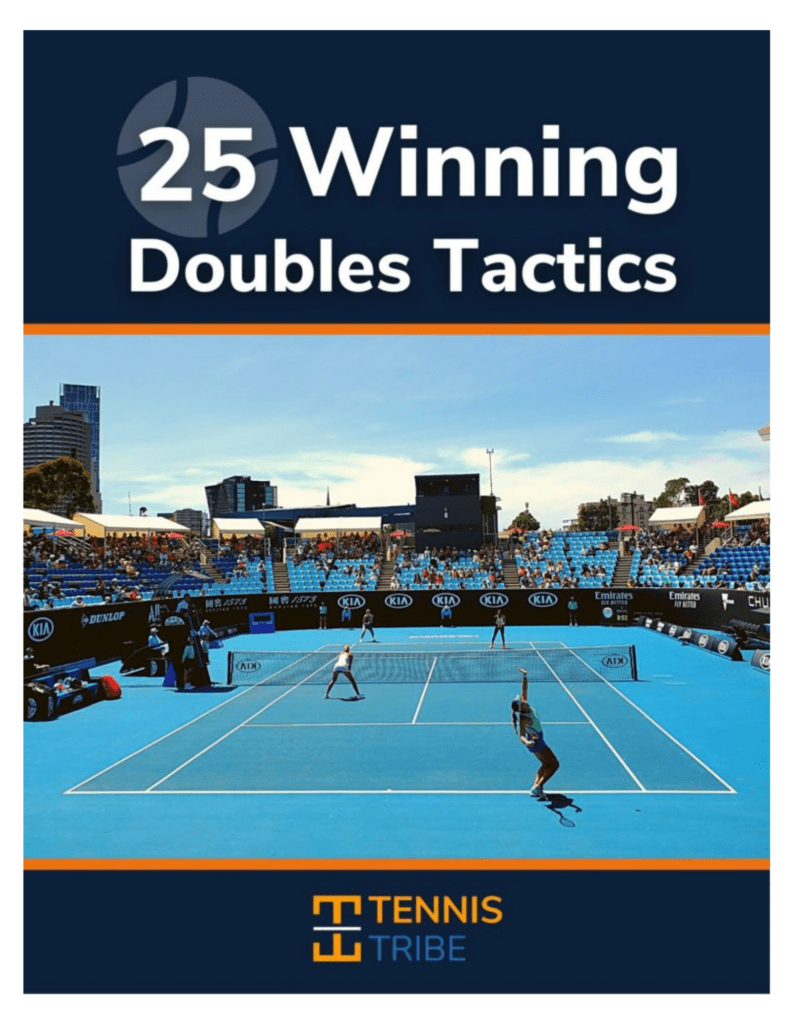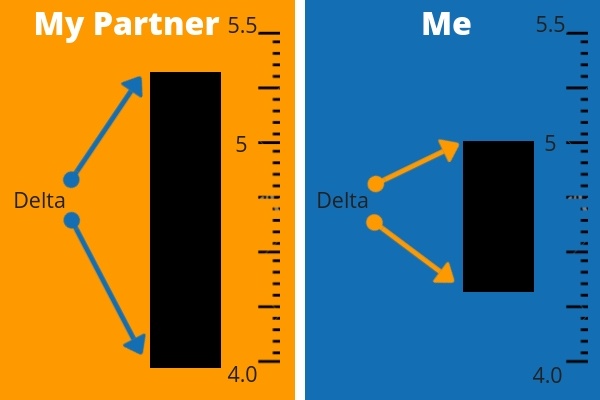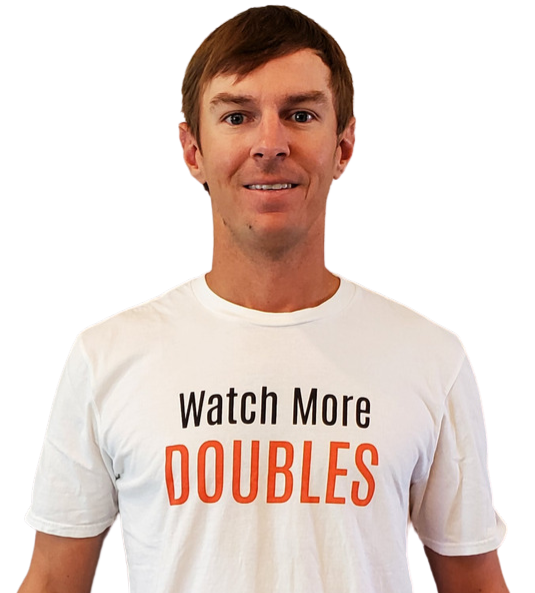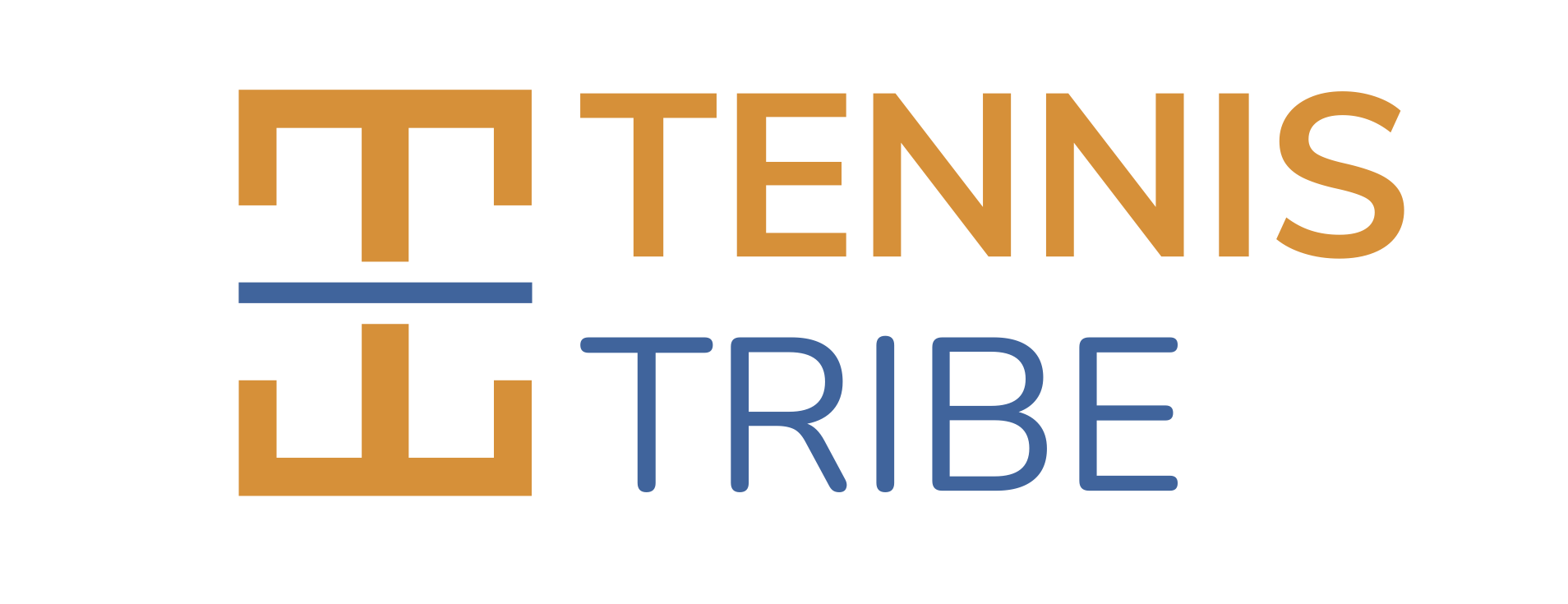Below I’m going to teach you a new way to think about how to improve your tennis game. Specifically, you’ll learn how to create a strategy to get better at tennis based on how you’re playing on any given day.
Credit To Kalim for giving me the term delta as it relates to tennis. He may have gotten it from someone else but I had never defined this idea so succinctly until I heard him say it.
Side Note: I majored in math in college so this may get a little nerdy. If you’re not a math nerd, skip to how to improve at tennis below. If you are a math nerd like me, read on, I think you’ll like this 🙂
How I Learned To Get Better At Tennis
We came out firing in the biggest tennis tournament of the year. We actually won our first match 6-1 6-1. This might not be that surprising for most tournaments in the first round, but this was different. Only the top 8 doubles players in all of Texas were invited, so every team was good. I had my normal doubles partner who I’d played with several times the previous year, but we actually hadn’t won any tournaments, so we knew it would be tough.
Our 2nd match was Saturday morning and we came out flat and lost in straight sets. Because of the round robin format though, we still had a shot to win our pool. Luckily we lost to a team that finished with 2 loses, so we just had to win our final match to get through. But this was the best team in out pool at 2-0. We came out firing again and won 6-1 6-3.
Weird right?
The team we lost to, lost later that day to the team that we had beaten 6-1 6-1. How is that possible?
It was our delta.

25 Winning Doubles Tactics Guaranteed to Help You Play Smarter
Ebook with 25 expert serve (7), return (5), net-play (5), baseline (4), & approach (4) tactics you can use in your next doubles match.
What is Your Delta in Tennis?
Your delta is the range of skill level you’re capable of playing during any given match.
Surely you’ve heard people say things like:
- She’s really streaky.
- He’s good when he’s on, but he can be really bad too.
What these comments really mean, is that the player has a large delta.
In my example above, it was actually my doubles partner who has a large delta. We were playing in a 4.5 doubles tournament, but he can play like a 4.0 tennis player, a good 5.0 player, or somewhere in between. So his delta might be 4.0 to maybe 5.3, a delta of 1.3.
In the first and last match he played somewhere above 5.0 but in the loss, he was around a 4.0 level player.

My delta is smaller, probably somewhere between 4.3 and 5.0, a delta of 0.7.
Your Delta’s Upper Limit
The upper limit of your delta is important to know because it shows you your highest potential skill level in tennis.
My partner’s upper limit is a 5.3, and mine is a 5.0. So when we both play our best, my partner is a better player.
Your Delta’s Lower Limit
Your lower limit is also important to recognize. It’s when you’re playing your worst tennis and you want to throw your racquet over the fence. Even more importantly, you need to recognize how you’re playing at the lower limit level and find a way out of it. We’ll cover that below.
In the example, my partner’s lower limit was 4.0 and mine is 4.3. So when both of us are playing at our worst, I’m a little better than my partner.
How to Improve at Tennis
So with our skill level defined based on our USTA rating, and our delta with its limits defined above, how do we actually get better at tennis?
Most people think that to get better at tennis you just have to work on your game. Go out and serve and hit forehands. But when we go out to play, especially for practice, we should have specific things in mind that we’re going to work on. More importantly, those specific things may change based on how we’re playing that day.
Why You Can’t Improve Your Average Rating in Tennis
Since my partner can play anywhere from a 4.0 to a 5.3, his average rating is a 4.65.
I can play anywhere from a 4.3 to a 5.0, so my average rating is also a 4.65.
So we just have to get that 4.65 number up to improve as a tennis player, right?
Yes, but… It’s the wrong number to focus on.
Instead, we should focus on getting our lower limit up and our upper limit up. Then, as a result, the average will naturally rise.
How To Fix It When You’re Playing Bad Tennis (or how to increase your delta’s lower limit)
The first problem we have to solve is improving our lower limit. Simply put, we have to figure out how to make our worst tennis not so bad 🙂
I’ve written about this before, but there are 3 steps to playing better when you’re not feeling right on the tennis court.
1 – Recognizing When & How You’re Playing Bad
This sounds easy, but you have to not only recognize when you’re playing bad but also recognize how you’re playing bad. For example, are you missing in the net a lot? Is it your serve that’s off? Volleys aren’t going in?
2 – Play To Your Strengths
After you know how you’re playing bad, you should find ways to hit more shots that you’re comfortable with through strategy. For example, when I’m playing my worst (at my lower limit), I start hitting every shot crosscourt and try to get to the net more. Playing doubles at the net is one of my strengths, and I know down the line shots (even volleys) don’t work when I’m not playing well.
3 – As You Raise Your Level, Go For More
Previously I wrote about Nadal’s practice strategy. As you start feeling your level increase, continue going for a little more.
You want to ride that edge of comfort and discomfort or you won’t improve.
How To Play Better Tennis When You’re Playing Good (or rules for increasing your delta’s upper limit)
Let’s say you’re already playing good in a practice hitting session or tennis match. How do you keep improving?
Let’s use John Isner’s 135 MPH serve as an example. Do you think he’s been hitting that serve since he was 12 years old? Of course not.
He kept pushing himself to do more, and go for more. And he kept growing to 6 feet 10 inches 🙂
Obviously, this example is on a different level of improvement than you or I can achieve, but it’s the same kind of improvement strategy.
To improve your tennis game when you’re at your best, you simply have to go for bigger, better, more difficult shots. And yes, that does mean you’ll miss more.
Typically it’s best to do this in practice, but you can do it in tennis matches too.
For example, a few months ago I was watching a pro doubles match and noticed they hit much better angles on their volleys that I do (shocker, I know). So over the past few months, I’ve been going for more angle on my volleys. For the first several matches, I missed a lot of volleys, but I kept adjusting and now am making a good percentage of them.
Now, my delta’s upper limit on my volleys is higher than it was 3 months ago. Said another way, my best volleys now are better than my best volleys used to be.
Free Weekly Doubles Lessons
Join the #1 Doubles Strategy Newsletter and get my Net Play Guide: 3 Doubles Tactics to Force Errors & Get More Easy Volleys for free!
– Will Boucek, ATP & WTA doubles strategy analyst

“I found your site a couple weeks ago and used your guide for net play. It worked well! Playing again this morning so we will see how it goes!”
– Julie, Club Doubles Player
Result: You’re Now A Better Tennis Player
Continuing to follow this process of improving your tennis game when you’re at your worst and best will help you get better overall. Rather than aimlessly going onto the tennis court and trying to hit shots, try to recognize now how you’re playing and which of your limits you’re trying to improve.
Remember that missing a serve or volley is not always a bad thing. You just need to have a purpose behind it.
So go out and develop a strategy to implement when you’re playing bad. Then, next time you’re serving good, go hit that kick serve up the T that you’re uncomfortable with but know you need in your arsenal to take your tennis game to the next level.

Good one – thanks for giving me credit for a math term from middle school 🙂 Other reasonably effective terms would be “range” or “variability”. Great tips on improving the game, as always.
Hahaa no problem! I just never made the connection to apply middle school math to tennis 😉
Thanks Kalim!
Hey Will,
I was just advised that if I, as a 3.5 level tennis player, play on a USTA team this spring, that I cannot be bumped to 4.0 for next year; and that the only way to do this would be to also play on a 3.5 USTA and prove there that I could be promoted to 4.0.
Is this correct?
Best regards,
Jim Durante
Hi Jim, I think they will be doing bump-ups and “re-rating” everyone in the fall of 2021.
I’m sure it could change though. You should check with your local CTA or Sectional office to be sure.